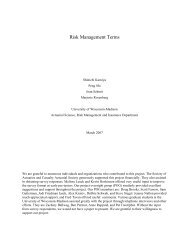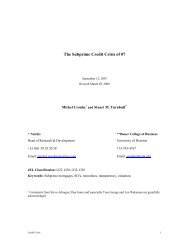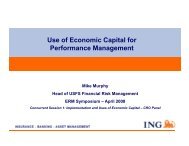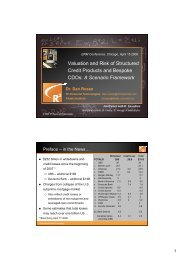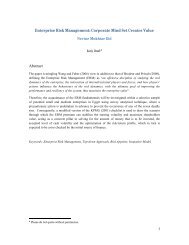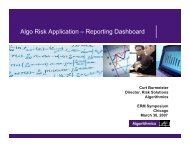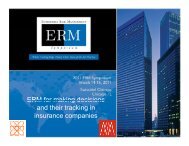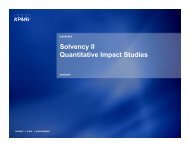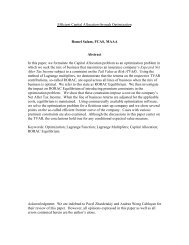Bayesian Risk Aggregation: Correlation ... - ERM Symposium
Bayesian Risk Aggregation: Correlation ... - ERM Symposium
Bayesian Risk Aggregation: Correlation ... - ERM Symposium
Create successful ePaper yourself
Turn your PDF publications into a flip-book with our unique Google optimized e-Paper software.
with an application to risk-type aggregation and elicitation Böcker [5]. The benefit for<br />
expert elicitation is due to a relationship between Kendall’s tau τi and the associated<br />
Gaussian copula parameter ri, which holds true for essentially all elliptical distributions,<br />
namely<br />
ri = sin(π τi/2) , i = 1, . . . , 6 . (5.1)<br />
Recall that τi ∈ [−1, 1], with τi = 1, (τi = −1) for complete positive (negative) depen-<br />
dence, and τi = 0 for independent risk types. Our suggestion is now to ask experts about<br />
their correlation estimates within an interval [−1, 1] where τi = {−1, 0, 1} can be used as<br />
anchors helping experts to calibrate their answers. Finally, the elicited value for τi can be<br />
transformed to the copula parameter ri by means of (5.1).<br />
<strong>Correlation</strong> elicitation using conditional and joint probabilities The correla-<br />
tion assessment described above requires the expert to think about two random variables<br />
simultaneously, i.e. it is a bivariate elicitation problem. A natural way to lower the com-<br />
plexity of the elicitation procedure is to reduce it to a univariate space. Specifically, it has<br />
been argued in Gokhale & Press [13] or O’Hagan et al. [19] that one-dimensional problems<br />
are more feasible for expert judgement as experts elicit univariate variables with a higher<br />
degree of accuracy.<br />
<strong>Correlation</strong> elicitation by means of indirect questions about conditional and joint prob-<br />
abilities was already described in Böcker [5] so that hrere we only briefly summarise the<br />
main results. First note that if d risk types are jointly distributed with a Gaussian copula<br />
with correlation matrix (Rij)ij, i, j = 1, . . . , d, any two risk types l and m (m = l) are<br />
coupled by a Gaussian copula with correlation parameter Rlm. Hence it is sufficient to<br />
consider the bivariate estimation problem.<br />
For two risk-type variables X and Y (and the definition that losses are positive) we<br />
can express their joint survival probability as<br />
P (X > x, Y > y) = 1 − P (X ≤ x) − P (Y ≤ y) + P (X ≤ x, Y ≤ y)<br />
= 1 − FX(x) − FY (y) + CR(FX(x), FY (y)) , x, y > 0 , (5.2)<br />
where FX and FY are the marginal distribution functions of X and Y , respectively, and<br />
CR(·, ·) is a bivariate Gaussian copula with unknown parameter R. Similarly, one may<br />
consider conditional loss probabilities of the form<br />
P (X > x|Y > y) =<br />
P (Y > y, X > x)<br />
P (Y > y)<br />
, x, y > 0 , (5.3)<br />
which depend on the copula correlation R via (5.2). Our strategy is now to elicit such joint<br />
and conditional probabilities for different threshold values of x and y. Since we assume<br />
19



